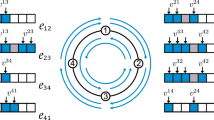Abstract
This paper presents green service level agreement (GSLA) awareness for the hybrid and traditional routing mechanisms by proposing a mathematical model for the amount of route greenness, and proposing two algorithms for the adoption of GSLA. The effect of the adoption of GSLA on a network that on average has green energy available for longer duration of a day is modeled by defining a one-step two-by-two Markov matrix and representing the transformation through a state machine. This work also examines a re-provisioning algorithm to deal with the effect of re-provisioning of the established lightpaths in case of a change in the topology of a network. To study the effect of adopting GSLA, two Scenarios with different arrival rates of connections and four performance parameters such as average emission per lambda, average connection length, GSLA satisfaction and success rate are defined and analyzed over NSFnet. Results reveal that adopting the GSLA by routing mechanisms decreases the resource efficiency with both light and heavy traffic in return for less reduction in emission as compared to green and hybrid routing mechanisms.













Similar content being viewed by others
Notes
3R regenerators perform Reamplification, Reshaping and Retiming of data pulse.
In this work routing refers to the first step of serving a connection request as finding a proper route, which is followed by the second step, the Resource Assignment (RA) for the computed route.
Emission topology change happens due to the fact that green energy availability has a finite duration and may not be available during the entire day.
References
Bathula BG, Vokkarane VM (2010) QoS-based manycasting over optical burst-switched (OBS) networks. IEEE/ACM Trans Netw 18(1):271–283
Berger L, Bryskin I, Zinin A, Coltun R (2008) The OSPF Opaque LSA Option, RFC 5250. http://www.rfc- editor.org/info/rfc5250
Bruckner T et al. (2014) Mitigation of climate change, annex III: Technology—specific cost and performance parameters, Intergovernmental panel on climate change
CBC (2014) U.S., China agree to cut greenhouse gases in bid to spur others to join. Retrieved Feb 3, 2015. http://www.cbc.ca/news/politics/u-s-china-agree-to-cut-greenhouse-gases-in-bid-to-spur-others-to-join-1.2832053
Coiro A, Listanti M, Valenti A (2011) Dynamic power-aware routing and wavelength assignment for green WDM optical networks. 2011 IEEE international conference on communications (ICC), pp 1–6
EPA (2012) Cap and trade. Retrieved May 10, 2015. http://www3.epa.gov/captrade/
Fazili Y, Nafarieh A, Robertson W (2013a) Adaptive green routing mechanism over optical networks. In: Procedia computer science; the 4th international conference on emerging ubiquitous systems and pervasive networks (EUSPN-2013), vol 21, pp 9–17
Fazili Y, Nafarieh A, Robertson W (2013b) Hybrid energy-aware and SLA-based routing mechanism over optical networks. In: Procedia computer science; the 4th international conference on ambient systems, networks and technologies (ANT 2013), vol 19, pp 1151–1158
Haque ME, Kien Le, Goiri I, Bianchini R, Nguyen TD (2013) Providing green SLAs in high performance computing clouds. Green Computing Conference (IGCC), 2013 International, pp 1–11
Kanter J (2010). Europe considers new taxes to promote ‘clean’ energy. Retrieved Jan 15, 2015. http://www.nytimes.com/2010/06/23/business/energy-environment/23carbon.html?_r=5&ref=cap_and_trade&
Leon-Garcia A, Widjaja I (2000) Communication networks: fundamental concepts and key architectures. McGraw-Hill, Boston
Minei I, Lucek J (2011) MPLS-enabled applications: Emerging developments and new technologies. Chichester, West Sussex, England; Hoboken, N.J.: Wiley
Mooney, C., S. M. (2015). In a major moment for climate policy, china, brazil, and the U.S. all announce new commitments. Retrieved Jun 30, 2015. https://www.washingtonpost.com/news/energy-environment/wp/2015/06/30/china-brazil-and-the-u-s-all-announce-new-climate-and-clean-energy-goals/
Nafarieh A, Fazili Y, Robertson W (2013a). Dynamic inter-domain negotiation for green algorithms in optical networks. In: Procedia computer science; the 4th international conference on emerging ubiquitous systems and pervasive networks (EUSPN-2013), vol 21, pp 25–32
Nafarieh A, Sivakumar S, Robertson W, Phillips W (2013b) Scalable approach to dynamic\SLA negotiation mechanism in protected shared mesh optical networks. Procedia Comput Sci 19:1143
Nafarieh A, Fazili Y, Raza MH, Robertson W (2014) Inter-domain hybrid metric as SLS dissemination mechanism in green optical networks. In: Procedia computer science; the 5th international conference on emerging ubiquitous systems and pervasive networks (EUSPN-2014), vol 37, pp 176–180
Nafarieh A, Raza M, Robertson W (2015) A comprehensive analysis of QoS-based routing mechanisms over shared mesh protected optical infrastructures. J Ambient Intell Humaniz Comput 6(4):463–472
Renzenbrink T (2013) How much electricity does the internet use?, 2015. http://www.techthefuture.com/technology/how-much-electricity-does-the-internet-use/
Siano P, Graditi G, Atrigna M, Piccolo A (2013) Designing and testing decision support and energy management systems for smart homes. J Ambient Intell Humaniz Comput 4(6):651–661
Wang J, Ricciardi S, Manolova AV, Ruepp S, Careglio D, Dittmann L (2012a) OSPF-TE extensions for green routing in optical networks. 2012 17th Opto-Electronics and Communications Conference (OECC), pp 411–412
Wang J, Ruepp S, Manolova AV, Dittmann L, Ricciardi S, Careglio D (2012b) Green-aware routing in GMPLS networks. In: 2012 International Conference on Computing, Networking and Communications (ICNC), pp 227–231
Wang J, Ricciardi S, Fagertun AM, Ruepp S, Careglio D, Dittmann L (2012c) Energy-aware routing optimization in dynamic GMPLS controlled optical networks. In: 2012 14th international conference on Transparent optical networks (ICTON), pp 1–4
Yu J, Wang X, Gao W (2015) Improvement and applications of secure outsourcing of scientific computations. J Ambient Intell Humaniz Comput 6(6):763–772. doi:10.1007/s12652-015-0280-0
Zang H, Jue JP, Mukherjee B (2000) A review of routing and wavelength assignment approaches for wavelength-routed optical WDM networks. Optical Netw Mag 1(1):47–60
Author information
Authors and Affiliations
Corresponding author
Rights and permissions
About this article
Cite this article
Fazili, Y., Nafarieh, A., Raza, M.H. et al. The effect of adopting green SLA on key parameters of optical WDM networks. J Ambient Intell Human Comput 7, 371–384 (2016). https://doi.org/10.1007/s12652-016-0364-5
Received:
Accepted:
Published:
Issue Date:
DOI: https://doi.org/10.1007/s12652-016-0364-5




